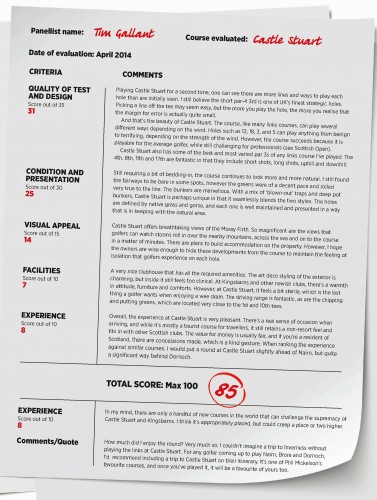How To Rate A Golf Course
Rob Smith, who oversees the Golf Monthly Course Rankings, suggests that there are benefits to be gained from learning how to rate a golf course


Rob Smith, who oversees the Golf Monthly Course Rankings, suggests that there are benefits to be gained from learning how to rate a golf course
How To Rate A Golf Course
For almost ten years, I have been lucky enough to be closely involved in the preparation of the Golf Monthly Top 100, and now Next 100, lists. I have always loved golf courses, possibly more than the game itself which so often beats you up, but if there is anything I have learnt as a result of this involvement, it is that the more I understand about design and assessment, the more fully I appreciate both courses and the game.
In a recent issue, I argued that there is no such thing as a bad course. On the basis that playing golf beats filling in your tax return or washing the car, I will stick with that view, but I would also suggest that for the real enthusiast, there is something to be gained by carrying out your own, informal course reviews.

The Golf Monthly assessment criteria have evolved with the best courses in mind, but can easily be adapted for use anywhere. The five main areas are quality of design and test, condition and presentation, visual appeal, facilities and experience. Whereas the premier league courses will score well in all five, everywhere you play should hopefully be able to score well in one or more category.

We all have our favourite courses, but by trying to make an objective assessment, we will soon understand why other courses are ranked better or worse in relation.
Subscribe to the Golf Monthly newsletter to stay up to date with all the latest tour news, equipment news, reviews, head-to-heads and buyer’s guides from our team of experienced experts.
For the Top 100, the criteria are weighted with the club golfer in mind, but you can re-allocate the marks in any way you want. If you feel that visual appeal is most important, then allocate 50% of the marks to this, and split the remaining half amongst the other four. You can then make your own personal rankings and will understand why you prefer one course to another.

By applying these criteria to the courses that we visit, in a relatively short time we can gain a far better understanding of which courses are better overall, better in specific areas, and better in our personal opinion. And for those who are involved in the running of a club, whether as an employee or on committee, it should be possible to take a realistic view on any potential improvements or changes.
Most often, we simply want to play golf and enjoy ourselves. Sometimes, however, it is interesting to stand back and have a good look at the reasons why we have our favourites. Why not have a look at the Golf Monthly assessment criteria and apply them to the courses that you play.

Rob has been playing golf for over 45 years and been a contributing editor for Golf Monthly since 2012. He specialises in course reviews and travel, and has played over 1,250 courses in almost 50 countries. In 2021, he played all 21 courses in East Lothian in 13 days. Last year, his tally was 78, exactly half of them for the first time. One of Rob's primary roles is helping to prepare the Top 100 Courses of the UK&I, of which he has played all, as well as the Next 100 where he is missing two in Scotland and two in Ireland. He has been a member of Tandridge for over 30 years where his handicap hovers around 15. You can contact him at r.smith896@btinternet.com.